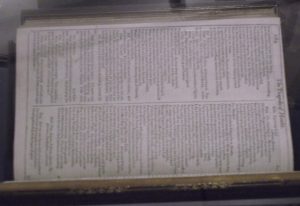This year, 2016, marks the four hundredth anniversary of William Shakespeare’s death. For some reason, we accord these round numbers some special kind of significance, and Shakespeare retrospectives are popping up left and right. Like everyone who loves language and the English language in particular, I am an awestruck admirer of the Bard and was delighted to hear (again, probably through my Twitter feed) that the Folger Shakespeare Library, located in Washington, DC, had decided to send their copies of the First Folio on tour to all fifty states, and that Amherst was the one location in Massachusetts which would host the book.
 I realized just this week that the folio would be on exhibit only for the rest of the month, so I resolved to make my way posthaste over to Amherst College on my lunch hour. Then I heard that a docent would give a talk about the Folio today at 2 pm, and I entered the event on my office calendar. Shortly before 2, a group of about fifty of us gathered just inside the front entrance to the Mead Art Museum (it happens to be Amherst Alumni Weekend), and right on time, Museum Educator Keely Sarr introduced herself and led us to the exhibit.
I realized just this week that the folio would be on exhibit only for the rest of the month, so I resolved to make my way posthaste over to Amherst College on my lunch hour. Then I heard that a docent would give a talk about the Folio today at 2 pm, and I entered the event on my office calendar. Shortly before 2, a group of about fifty of us gathered just inside the front entrance to the Mead Art Museum (it happens to be Amherst Alumni Weekend), and right on time, Museum Educator Keely Sarr introduced herself and led us to the exhibit.
The First Folio, published in 1623, is commonly known as “the book that gave us Shakespeare,” the reason for this being that half the plays in it had not been previously published. In fact, among these 18 plays that might have been lost to history are such classics as Julius Caesar, Macbeth, and The Tempest. This particular book, seen here in its protective glass case (sorry that the photo was taken sideways), is one of only 750 copies printed; 233 known copies survive, and the Folger Library owns 82 of them. Printed on rag paper rather than the less durable wood pulp, the folio is a large book; it is comprised of 900 double-columned pages. (In printing, a folio is a book printed on a sheet of paper folded just once, as contrasted with a quarto, or an octavo, which are smaller, due to multiple folds.) After Shakespeare’s death, John Heminge and Henry Condell, two friends and colleagues in the King’s Men, collected almost all of his plays, thirty-six total, for this edition, which also includes an engraved portrait of the playwright, mostly likely an authentic image of him. This was also the first collection to divide the plays into comedies, histories, and tragedies. The Second Folio was published about ten years later, and in the Third and Fourth Folios, additional plays were included, although most of these are not considered authentic by modern scholars.
After Shakespeare’s death, John Heminge and Henry Condell, two friends and colleagues in the King’s Men, collected almost all of his plays, thirty-six total, for this edition, which also includes an engraved portrait of the playwright, mostly likely an authentic image of him. This was also the first collection to divide the plays into comedies, histories, and tragedies. The Second Folio was published about ten years later, and in the Third and Fourth Folios, additional plays were included, although most of these are not considered authentic by modern scholars.
As odd as it may sound to us today, accustomed as we are to cheap paper, digital versioning, copyright laws, and near obsessive concern with documenting our lives and achievements, we don’t have any drafts of Shakespeare’s plays written in his hand. In his time, manuscripts of plays were written in shorthand and given to a scribe. The printing process was extensive, because a compositor had to set type from this transcription, and the compositors were not all equally skilled or experienced. In fact, the first folios are not identical, because proofreading and corrections took place at the same time as printing (note that at this time, spelling had not been regularized as it is today). The folio would have sold for a pound, which was equivalent to between $100 and $250 in today’s currency, which is significant. In Shakespeare’s time, plays were considered popular entertainment, not literature; they were meant to be performed, in contrast to works printed in folio format which were meant to be read, studied, and collected.
I wondered why Amherst College was chosen to host this traveling exhibit, then I realized that the founder of the Folger Library, oil executive Henry Clay Folger, was a graduate of Amherst College (well duh). Folger’s wife Emily, who earned a master’s degree from Vassar, wrote her thesis on Shakespeare; the couple worked together on their rare book collecting, with an emphasis on works by Shakespeare and from Elizabethan England. Henry bought his first rare book in 1889; the Shakespeare Library opened in 1932, a gift to the American people from founders Henry and Emily Folger.
In the exhibit room, the book was set up in the center, and hung on the walls were huge posters with “fun facts” about Shakespeare and the plays. Although you can’t see it in my photo, the book is open to Hamlet’s “To be or not to be” soliloquy; the curator chose to display this passage in recognition of how characters like Hamlet have become archetypes in modern culture, influencing more than just literature. For example, on display in the exhibit room are two paintings of Ophelia, both owned by the College. One is an oil painting from 1875 by British artist Thomas Dicksee, depicting a despairing Ophelia at the edge of the pool she’s about to drown in. The other is a lithograph made in 1996–97 by American artist Louise Bourgeois; she depicts Ophelia drowning in abstract blue waves, but Ophelia and Hamlet are embracing each other so tightly that he’ll probably drown too (that didn’t happen in the play, although Hamlet and almost everybody else dies tragically).
Speaking of Shakespeare, I have a friend who decided to read all of Shakespeare’s plays as a retirement project (as I understand it, he’s more than half-way done at this point). When I heard about his goal, I wondered if I would be interested in doing something like that, but I decided that I would not. I actually do not enjoy reading plays; instead, I might choose as one of my retirement projects seeing all of Shakespeare’s plays performed on stage (or as a film version). I do wonder if there are enough repertory companies somewhere in the world so that I could really do this.